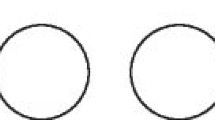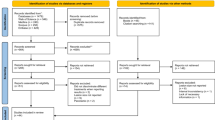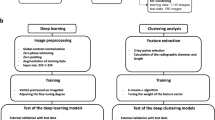Abstract
Aim
The aim of the current systematic review was to investigate differences in the measurement of working length in primary teeth between electronic apex locators (EAL) and radiographic methods (conventional radiography [CR] and digital radiography [DR]).
Methods
A systematic search was conducted in six electronic databases (Medline via PubMed, Web of Science, Science Direct, Virtual Health Library, Scopus and Cochrane Database of Systematic Reviews). Gray literature and reference lists of included studies were also examined. The guiding question of the study was formulated using the PECO strategy (Population, Exposure, Comparator, Outcome): P: primary teeth submitted to pulpectomy; E: measurement of working length using the radiographic methods; C: measurement of working length using electronic apex locator; O: difference in working length. The methodological quality (QUADAS-2) and certainty of the evidence (GRADE) were assessed. Meta-analyses were performed, e foram considerados os tipos de radiografia, grupo de dentes, geração de localizadores apicais. I² statistics were calculated.
Results
Twenty-five studies were included in the review. Of these, eighteen studies were eligible for meta-analysis. Most studies demonstrated fair methodological quality. The working length measured using CR was, on average, 0.52 mm greater when compared to EAL (95% CI: 0.15–0.89, I2 = 75%). When comparing EAL and DR, no statistically significant difference was found (MD = 0.06 mm, 95% CI: –0.12 to 0.24; I2 = 0%). The majority of articles (n = 20) were considered to have fair quality and five had high quality.
Conclusions
The findings of the present review demonstrate a difference in the measurement of working length using CR in comparison with EAL. No difference was found between the EAL and DR methods. The certainty of the evidence was considered low for all outcomes.
This is a preview of subscription content, access via your institution
Access options
Subscribe to this journal
Receive 4 print issues and online access
$259.00 per year
only $64.75 per issue
Buy this article
- Purchase on SpringerLink
- Instant access to full article PDF
Prices may be subject to local taxes which are calculated during checkout





Similar content being viewed by others
Data availability
The data supporting this article can be made available by the corresponding author upon request.
References
Wang YL, Chang HH, Kuo CI, Chen SK, Guo MK, Huang GF, et al. A study on the root canal morphology of primary molars by high-resolution computed tomography. J Dent Sci. 2013;8:321–7.
Chen X, Liu X, Zhong J. Clinical and radiographic evaluation of pulpectomy in primary teeth: a 18-months clinical randomized controlled trial. Head Face Med. 2017;13:12.
Moskovitz M, Yahav D, Tickotsky N, Holan G. Long-term follow up of root canal treated primary molars. Int J Paediatr Dent. 2010;20:207–13.
Neelakantan P, Subbarao CV. An analysis of the antimicrobial activity of ten root canal sealers-a duration based in vitro evaluation. J Clin Pediatr Dent. 2008;33:117–22.
Silva EJNL, Herrera DR, Souza-Júnior EJ, Rosa TP. Evaluation of the multifrequency electronic apex locator Joypex 5 in primary teeth. Eur Arch Paediatr Dent. 2014;15:51–4.
Mente J, Seidel J, Buchalla W, Koch MJ. Electronic determination of root canal length in primary teeth with and without root resorption. Int Endod J. 2002;35:447–52.
Bhat KV, Shetty P, Anandakrishna L. A comparative evaluation of accuracy of new-generation electronic apex locator with conventional radiography to determine working length in primary teeth: an in vivo study. Int J Clin Pediatr Dent. 2017;10:34–36.
Mello-Moura AC, Moura-Netto C, Araki AT, Guedes-Pinto AC, Mendes FM. Ex vivo performance of five methods for root canal length determination in primary anterior teeth. Int Endod J. 2010;43:142–7.
Mello-Moura ACV, Bresolin CR, Moura-Netto C, Ito A, Araki AT, Imparato JCP, et al. Use of artificial primary teeth for endodontic laboratory research: experiments related to canal length determination. BMC Oral Health. 2017;17:131.
Sunada I. New method for measuring the length of the Root Canal. J Dent Res. 1962;41.2:375–87.
Angwaravong O, Panitvisai P. Accuracy of an electronic apex locator in primary teeth with root resorption. Int Endod J. 2009;42:115–21.
Leonardo MR, Silva LA, Nelson-Filho P, Silva RA, Raffaini MS. Ex vivo evaluation of the accuracy of two electronic apex locators during root canal length determination in primary teeth. Int Endod J. 2008;41:317–21.
Leonardo MR, da Silva LA, Nelson-Filho P, da Silva RA, Lucisano MP. Ex vivo accuracy of an apex locator using digital signal processing in primary teeth. Pediatr Dent. 2009;31:320–2.
Beltrame AP, Triches TC, Sartori N, Bolan M. Electronic determination of root canal working length in primary molar teeth: an in vivo and ex vivo study. Int Endod J. 2011;44:402–6.
Neena IE, Ananthraj A, Praveen P, Karthik V, Rani P. Comparison of digital radiography and apex locator with the conventional method in root length determination of primary teeth. J Indian Soc Pedod Prev Dent. 2011;29:300–4.
Odabas ME, Bodur H, Tulunoglu O, Alacam A. Accuracy of an electronic apex locator: a clinical evaluation in primary molars with and without resorption. J Clin Pediatr Dent. 2011;35:255–8.
Oznurhan F, Ünal M, Kapdan A, Ozturk C, Aksoy S. Clinical evaluation of apex locator and radiography in primary teeth. Int J Paediatr Dent. 2015;25:199–203.
Abdullah A, Singh N, Rathore MS, Tandon S, Rajkumar B. Comparative evaluation of electronic apex locators and radiovisiography for working length determination in primary teeth in vivo. Int J Clin Pediatr Dent 2016;9:118–23.
Ahmad IA, Pani SC. Accuracy of electronic apex locators in primary teeth: a meta-analysis. Int Endod J. 2015;48:298–307.
Paradiso D, Tullio A, Bensi C. Working length determination in primary teeth pulpectomy: a systematic review and meta-analysis. Aust Endod J. 2022;00:1–11.
Vitali FC, Santos PS, Cardoso M, Massignan C, Garcia LDFR, Bortoluzzi EA, et al. Are electronic apex locators accurate in determining working length in primary teeth pulpectomies? A systematic review and meta-analysis of clinical studies. Int Endod J. 2022;55:989–1009.
Nellamakkada K, Patil SS, Kakanur M, Kumar RS, Thakur R. A clinical evaluation of two electronic apex locators and conventional radiography in working length determination in primary molar and its influence on children’s behavioral responses. J Indian Soc Pedod Prev Dent. 2020;38:158–63.
Page MJ, McKenzie JE, Bossuyt PM, Boutron I, Hoffmann TC, Mulrow CD, et al. The PRISMA 2020 statement: an updated guideline for reporting systematic review. BMJ. 2021;372:71.
Higgins JPT, Green S Cochrane Handbook for Systematic Reviews of Interventions. Version 5.1.0. The Cochrane Collaboration. 2011.
Atkins D, Best D, Briss PA, Eccles M, Falck-Ytter Y, Flottorp S, et al. GRADE Working Group. Grading quality of evidence and strength of recommendations. BMJ (Clinical research ed.). 2004 328, 1490.
Awasthi Awasthi D, Kambalimath HS, Sharma DS. Comparison of radiovisiography and apex locator with the conventional method in root canal length determination of primary teeth. Natl J Med Dent Res. 2017;6:297–302.
Balaji K, Pravallika TS. A comparative evaluation of the accuracy of two electronic apex locators and radiovisiography to determine the working length. World J Dent. 2019;10:393–5.
Brum ICS, Maia CA, Diniz MVT, Fernandes AM, Fernandes MLMF. Agreement between working length measurements in primary teeth obtained by radiographs or apical locators. Pesqui Brasileira em Odontopediatria e Clínica Integrada. 2020;20:e4525.
Çalışkan S, Delikan E, Cantekin K. Evaluation of methods for determining working length in root canal treatment for primary molars: an in-vivo study. Cyprus J Med Sci. 2021;6:141–5.
Chougule RB, Padmanabhan MY, Mandal MS. A comparative evaluation of root canal length measurement techniques in primary teeth. Pediatr Dent. 2012;34:53–6.
Dandempally A, Muppa R, Duddu MK, Bhupatiraju P, Nallanchakrava S. Formulating a regression equation for determination of working length in primary molars using apex locators: a clinical study. Eur Arch Paediatr Dent: Off J Eur Acad Paediatr Dent. 2013;14:369–74.
Davalbhakta RN, Gokhale NS, Hugar SM, Badakar CM, Gowtham A, Soneta SP. Comparative evaluation of Root ZX Mini® apex locator and radiovisiography in determining the working length of primary molars: An In Vivo study. J Oral Biol Craniofac Res. 2021;11:257–62.
de Alencar NA, Oriano MD, Bolan M, Cardoso M. Is there any difference in length measurement methods for pulpectomies in primary teeth? A double-blind, controlled clinical trial. Int J Paediatr Dent. 2019;29:712–9.
Hafiz Z. Accuracy of the electronic apex locator in relation to patient’s cooperative behavior. Egypt Dent J. 2018;64:911–6.
Khan SA, Khanna R, Navit S, et al. Comparison of radiovisiography, an apex locator and an integrated endomotor-inbuilt apex locator in primary teeth endometrics. Int J Clin Pediatr Dent. 2022;15:S18–S21.
Koruyucu M, Bayram M, Kasımoǧlu Y, Seymen F. Comparison of root canal length measurement methods in primary teeth. Dent 3000. 2018;1:a001.
Kumar LV, Sreelakshmi N, Reddy ER, Manjula M, ST Rani, Rajesh A. Clinical evaluation of conventional radiography, radiovisiography, and an electronic apex locator in determining the working length in primary teeth. Pediatr Dent. 2016;38:37–41.
Patiño-Marín N, Zavala-Alonso NV, Martínez-Castañón GA, Sánchez-Benavides N, Villanueva-Gordillo M, Loyola-Rodríguez JP, et al. Clinical evaluation of the accuracy of conventional radiography and apex locators in primary teeth. Pediatr Dent. 2011;33:19–22.
Rathore K, Tandon S, Sharma M, et al. Comparison of accuracy of apex locator with tactile and conventional radiographic method for working length determination in primary and permanent teeth. Int J Clin Pediatr Dent. 2020;13:235–9.
Sankar P, Jeevanandan G. Clinical comparison of two electronic apex locators in working length determination as compared to conventional radiography in primary molars. Int J Dent Oral Sci. 2021;8:3146–50.
Saritha S, Uloopi KS, Vinay C, Chandra Sekhar R, Rao VV. Clinical evaluation of Root ZX II electronic apex locator in primary teeth. Eur Arch Paediatr Dent: Off J Eur Acad Paediatr Dent. 2012;13:32–5.
Senthil D, Eagappan AR, Sathiyajeeva J, Ramkumar S, Srinivasan D, Louis J. Comparison of the accuracy of Propex II electronic apex locator and conventional radiography for working length determination in primary anterior teeth. J Int Oral Health. 2016;8:729–32.
Sivadas G, Sudha P, Shenoy R, Rao A, Suprabha BS. Accuracy of apex locator for root canal length determination of deciduous molars compared to conventional radiograph. J Interdiscip Dent. 2013;3:163–6.
Soruri M, Moeini M, Rekabi S, Bahrololumi Z, Moeini M, Zare MR. A clinical comparison of the accuracy of an electronic apex locator (EAL) and radiography in determination of root canal length in primary molars. Am J Res Commun. 2013;1:119–27.
Wankhade AD, Kumar R, Singh RK, Chandra A. Root canal length determination by different methods in primary teeth: an in vivo study. Pediatr Dent. 2013;35:E38–E42.
Basso MD, Jeremias F, Cordeiro RC, Santos-Pinto L. Digital radiography for determination of primary tooth length: in vivo and ex vivo studies. Sci World J. 2015; 2015:939045.
Farida A, Maryam E, Ali M, Ehsan M, Sajad Y, Soraya K. A comparison between conventional and digital radiography in root canal working length determination. Indian J Dent Res 2013;24:229–33.
Ebrahim AK, Yoshioka T, Kobayashi C, Suda H. The effects of file size, sodium hypochlorite and blood on the accuracy of Root ZX apex locator in enlarged root canals: an in vitro study. Aust Dent J 2006;51:153–7.
Comin CL, Menini M, Cavalleri G. A comparison between two fourth generation apex locators. Minerva Stomatol. 2012;61:183.
Chakravarthy Pishipati KV. An in vitro comparison of propex II apex locator to standard radiographic method. Iran Endod J. 2013;8:114–7.
Gurel MA, Helvacioglu Kivanc B, Ekici A. A comparative assessment of the accuracies of Raypex 5, Raypex 6, iPex and iPex II electronic apex locators: an in vitro study. J Istanb Univ Fac Dent. 2017;51:28–33.
Jadhav GR, Mittal P, Patil V, Kandekar P, Kulkarni A, Shinde S, et al. Accuracy of different apex locators in teeth with simulated apical root resorption: an in vitro study. Folia Med (Plovdiv). 2018;60:624–31.
Khattak O, Raidullah E, Francis ML. A comparative assessment of the accuracy of electronic apex locator (Root ZX) in the presence of commonly used irrigating solutions. J Clin Exp Dent. 2014;1:e41–e46.
Huda W, Rill LN, Benn DK, Pettigrew JC. Comparison of a photostimulable phosphor system with film for dental radiology. Oral Surg Oral Med Oral Pathol Oral Radio Endod. 1997;83:725–31.
Borg E, Attaelmanan A, Grondahl HG. Subjective image quality of solid-state and photostimulable phosphor systems for digital intraoral radiography. Dentomaxillofac Radiol. 2000;29:70–5.
Kaeppler G, Vogel A, Axmann-Krcmar D. Intra-oral storage phosphor and conventional radiography in the assessment of alveolar bone structures. Dentomaxillofac Radiol. 2000;29:362–7.
Emmott LF. The digital revolution, images and X-rays. NY State Dent J. 2005;71:40–2.
Nair KM, Nair UP. Digital and advanced imaging in endodontics: a review. J Endod. 2007;33:1–6.
Schmitd LB, Lima TdeC, Chinellato LE, et al. Comparison of radiographic measurements obtained with conventional and indirect digital imaging during endodontic treatment. J Appl Oral Sci. 2008;16:167–70.
Kielbassa AA, Muller U, Munz I, Monting JS. Clinical evaluation of the measuring accuracy of ROOT ZX in primary teeth. Oral Surg Oral Med Oral Pathol Oral Radiol Endod. 2003;95:94–100.
Tosun G, Erdemir A, Eldeniz AU, Sermet U, Sener Y. Accuracy of two electronic apex locators in primary teeth with and without apical resorption: a laboratory study. Int Endod J. 2008;41:436–41.
Funding
This study was partially supported by CAPES (Coordenação de Aperfeiçoamento de Pessoal de Nível Superior) for supporting academic and professional development. This study was financed in part by Coordenação de Aperfeiçoamento de Pessoal de Nível Superior—Brasil (Capes)—Finance Code 001, The Research Foundation of the State of Minas Gerais (FAPEMIG) APQ: 03370-15 and the National Council for Scientific and Technological Development (CNPQ), Brazil.
Author information
Authors and Affiliations
Contributions
PSM, IBF, LVM and GFM worked at methodology, investigation and writing of the article. SGMF worked at conceptualization, methodology, investigation, writing—review and editing supervision. GMS worked at conceptualization; methodology; statistical analysis and writing—review. MLRJ and IBF worked at conceptualization; methodology; writing—review and editing supervision.
Corresponding author
Ethics declarations
Competing interests
The authors declare no competing interests.
Additional information
Publisher’s note Springer Nature remains neutral with regard to jurisdictional claims in published maps and institutional affiliations.
Supplementary information
Rights and permissions
Springer Nature or its licensor (e.g. a society or other partner) holds exclusive rights to this article under a publishing agreement with the author(s) or other rightsholder(s); author self-archiving of the accepted manuscript version of this article is solely governed by the terms of such publishing agreement and applicable law.
About this article
Cite this article
Mourão, P.S., Fernandes, I.B., Moreira, L.V. et al. Conventional methods and electronic apical locator in determining working length in different primary teeth: systematic review and meta-analysis of clinical studies. Evid Based Dent 26, 116 (2025). https://doi.org/10.1038/s41432-024-01105-4
Received:
Accepted:
Published:
Issue date:
DOI: https://doi.org/10.1038/s41432-024-01105-4



